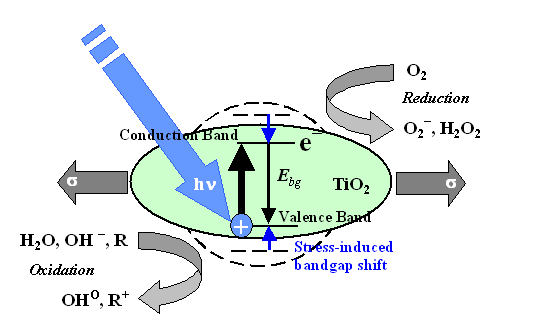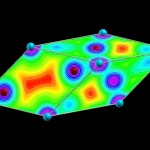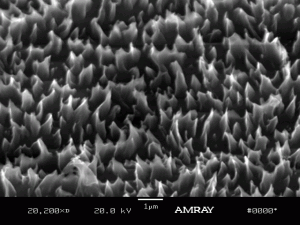The Greek letter “nu” in Nanoptek’s logo is the international symbol for the frequency of light.
Nearly everyone knows Einstein’s famous equation relating energy to the product of mass M and the square of the speed of light C as E=MC2.
But an equally important contribution from this great physicist is the equation relating energy to the product of the frequency of light “ν” and Plank’s Constant “h” that explains the “photoelectric effect”, or the emission of electrons in a metal or semiconductor caused by photons of light (here, semiconductors are materials that are normally electrically insulating and are conductive when illuminated):
E=hν
where E can be expressed as electron volts (eV). This equation is the essence of production of electricity by a photovoltaic panel, in which the semiconductor is usually silicon. However, if the light has a frequency (which we perceive as “color” when visible, and invisible when ultraviolet) that can’t be absorbed by the semiconductor, there is no flow of electrons. All semiconductors have an electronic band structure that includes a valance band and conduction band, and the photon must have enough energy to move an electron from the valance band up to the conduction band. The difference in energy between these band levels is what the photon must supply. It is called the “bandgap” of the semiconductor ( Ebg in the figure at left) and is also measured in electron volts (eV).Photocatalysts are semiconductors that, when activated by light having energy equal to or more than their bandgap, act as catalysts. Catalysts are agents that reduce the energy required for a chemical reaction, or enable a chemical reaction to proceed at all, or speed up the reaction rate of a chemical reaction, and are not consumed in the process. Titania (titanium dioxide or TiO2) is such a photocatalyst. It is also safe, low-cost, abundant, and inert in an electrolyte. Honda and Fujishima discovered in 1972 that a titania photoanode immersed in an aqueous electrolyte together with an externally connected cathode will split the electrolyte into hydrogen and oxygen when illuminated with ultraviolet (<400nm) light. Holes (positive charges) generated in the illuminated titania dissociate water molecules in the electrolyte into H+ (hydrogen) and OH– (hydroxy) ions. The latter combine with the holes at the anode to form oxygen gas, while the former migrate to the cathode, where they combine with electrons (via the external circuit) to form hydrogen gas. The titania photocatalyst greatly reduces the threshold energy for this dissociation reaction, so that much less external power is required than for conventional electrolysis. Without the external circuit and separate cathode, UV-illuminated titania powders instead produce hydroxyl radicals (OHo) from even just ambient humidity in air. As seen in the figure above, this happens when the hole accepts an electron from an adsorbed OH– hydroxy ion. These highly reactive OHo radicals are powerful oxidizing agents, second only to fluorine and many times stronger than concentrated bleach. Hydrogen peroxide (H2O2) and oxygen radicals (O2– ), also powerful oxidizers, are also formed. These agents have been shown to act together or separately to dissociate many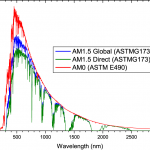 organic molecules and other pollutants into harmless compounds, such that they can be used to remove contaminants from air and water. killing even drug-resistant bacteria and viruses on surfaces or in air and water, and reducing NOx and other pollutants in air— and much more. And while titania photocatalysts are found now in commercial applications from self-cleaning films on windows to self-cleaning buildings built from titania-containing concrete to indoor air and surface disinfection when combined with artificial ultraviolet light sources, this photocatalyst has not lived up to its enormous potential.
organic molecules and other pollutants into harmless compounds, such that they can be used to remove contaminants from air and water. killing even drug-resistant bacteria and viruses on surfaces or in air and water, and reducing NOx and other pollutants in air— and much more. And while titania photocatalysts are found now in commercial applications from self-cleaning films on windows to self-cleaning buildings built from titania-containing concrete to indoor air and surface disinfection when combined with artificial ultraviolet light sources, this photocatalyst has not lived up to its enormous potential. 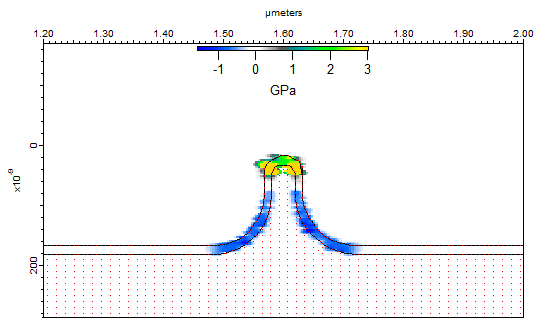
The reason for this is that there is not very much ultraviolet light in sunlight (<2% below 400 nm, left), and even less in indoor lighting. Supplying artificial ultraviolet light to activate it creates ozone pollution, and ultraviolet illumination is not efficient to produce, requiring more electricity per lumen compared to visible light. And titania does not use the little ultraviolet light that there is very efficiently. In the nearly forty years since Honda and Fujishima’s discovery, researchers have strived to produce photocatalysts that absorb more of the plentiful visible light, by reducing the bandgap of photocatalysts such as titania so that visible light, which has a smaller frequency and so lower energy, will be sufficient to traverse the bandgap and be absorbed in the process of freeing an electron. This effort to produce visible light photocatalysts is called bandgap engineering or bandgap shifting, and is one of the most exciting applications of nano-optical technology. Usually it involves either doping of titania or other photocatalysts by adding ions in such a way that visible light is absorbed. This is difficult to do, and even when it can be done often results in the photocatalyst no longer being inert, which is required for a catalyst, such that it does not last very long. Further, while doping can increase the absorption of light into the visible, that same doping often also reduces the effectiveness of that absorbed light by allowing the electrons and positive holes to recombine faster, before they can do any catalytic work.
Nanoptek’s researchers understood that very high tensile stress (σ in the figure at top) applied to a semiconductor will lower its bandgap (just as pressure will increase its bandgap). This is well known in the semiconductor industry and is often a problem in the multi-step production of semiconductor devices, where stresses caused by each process step must be carefully controlled or allowed for to meet device performance specifications. Tensile stress enlarges the atomic lattice, which in turn reduces the electron potential (red in the electron potential map of anatase titania at left), meaning it takes less photon energy (hν) to move an electron from the valence to the conduction band. The first figure at top shows this schematically as the valence and conduction bands closing together to form a smaller bandgap as the now-green titania particle is stressed from its original dashed-line state.
Nanoptek develops and applies various proprietary stress-inducing technologies at the nanoscale (such as the titania nano-structures seen at left below) to change the optical characteristics, ie how light is absorbed and used, of semiconducting oxides and of titania in particular. Computer modeling of one of our techniques shows how stress in the titania film can exceed 3 GPa (3 billion pascals) as it is formed on a nanostructure. Nanoptek’s family of titania photocatalysts can be optimized for maximum conversion efficiency, or for maximum light absorption, and combinations thereof. The titania is still robust and inert.
Nanoptek UV-Blue™ titania photocatalyst, in thin film form, not only absorbs more of the ultraviolet light spectrum, but converts 90% of it into electrons, while also absorbing and converting more of the abundant blue light in diffuse sunlight. Nanoptek’s Solar Hydrogen Generators™ employ this photocatalyst for carbon-free low-cost production of hydrogen anywhere in the world from sunlight and water with as little as 1/3 the electricity normally required, for use in distributed electrical energy storage, backup power, grid stabilization, manufacturing, and transportation. It can also be used with artificial UV sources for more efficient air and water purification.
Nanoptek Visible Light Titania™ photocatalyst works in visible light such as sunlight or even indoor lighting to dissociate methylene blue and rhodamine B dyes in water more than 20X faster than the current industry standard titania. The powder can be mixed into the water and reclaimed, or it can be adhered to a support structure for air and water filtration.
